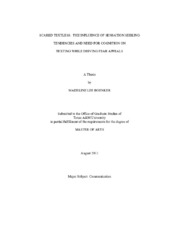| dc.description.abstract | Texting is ubiquitous; the International Association for the Wireless Telecommunications Industry reported that 4.1 billion text messages were sent per day in the first half of 2009. In isolation, texting does not injure individuals; however, when combined with driving, lives have changed for the worse. The National Safety Council estimates that 1.6 million crashes per year can be attributed to distracted drivers either talking on cell phones or texting while driving and nearly 28 percent of all crashes in the United States can be ascribed to these behaviors. An increasing number of texting while driving fear appeal campaigns are being utilized in the media. Therefore, the purpose of this research was to create and test theoretically-based messages aimed at discouraging texting while driving.
Formative research along with the Extended Parallel Process Model was used for guidance in the creation of the fear appeal messages. No low threat message was used for the main study after repeated message validations failed. For the study, three high threat messages varied only by a single paragraph which targeted beliefs about benefits, mastery, and ubiquity of texting while driving. 155 undergraduates at Texas A & M University completed a pretest, read the high threat message, and answered a posttest. Need for cognition and sensation seeking tendencies were measured in order to understand the effects such personality traits have on message perceptions. Five major outcomes were revealed even though numerous hypotheses were unsupported. There was a significant interaction between perceived threat and sensation seeking tendencies on message realism. There was a significant interaction between perceived threat and need for cognition on message realism. There was a significant interaction between perceived threat and need for cognition on message accuracy. There was a significant interaction between perceived threat and need for cognition on attitudes. There was a significant positive correlation between perceived threat and perceived message sensation value.
This project provides support that sensation seeking tendencies and need for cognition do interacted with perceived threat on perceptions of message effectiveness and that perceived message sensation value was positively related to perceived threat. Results also revealed the prevalence of texting while driving behavior and relationships between personality traits and texting while driving. Sensation seeking tendencies were positively correlated with initiating text messages while driving. Need for cognition was negatively correlated with reading and replying to text messages while driving. | en |


